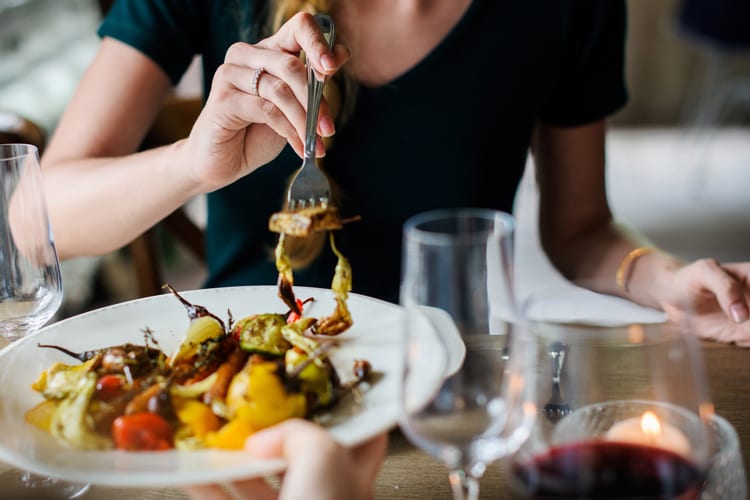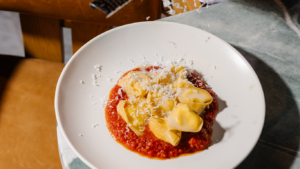A healthy diet takes dedicated focus and intention. So what do you do when you set good and healthy intentions when on the road? Here are some tips for staying on track when travel plans arise including starting the day right, choosing healthy meals while on-the-go, and establishing healthy eating habits.
Start with the Most Important Meal of the Day: Breakfast
Whatever goals you have be it weight loss, fat loss, or lean mass gains, breakfast sets the metabolic rate for the day and fuels the body for whatever is to come. It should be balanced and nutrient-dense.
As part of a healthy diet, breakfast should include a lean protein, a whole fruit or whole grain carbohydrate option, and very little sugar.
Healthy Breakfast Options That Are Quick and Convenient

Bagels are a quick, carb-heavy pick, but can be made into a balanced meal:
• Add a lean protein source – egg whites, grilled chicken, or tofu.
• Skip the cream cheese.
• Include vegetables.
Smoothies are an easy first step when creating healthy eating habits. They are loaded with vitamins and nutrients and are low-calorie. Here are some healthy options for your breakfast smoothie:
• Leafy greens make a great base and add lots of nutrition, including iron and protein.
• Whole vegetables like carrots, celery, and zucchini add vitamins, fiber and flavor.
• Fresh, whole fruits add more nutrients and sweeten the mix. Think apples, pears, bananas, strawberries, pineapple and melon.
• Don’t be afraid to add healthy fats. Fats are necessary for good health, as discussed in our article, Explaining Fats’ Function to Clients, and make smoothies nice and creamy. Simply add half an avocado or a tablespoon of nut butter.
• Oats add fiber as do chia seeds and flaxseed, which also include healthy fats.
• Add protein powder to boost calories and protein intake.
When hitting the drive-thru is the only option, there are always healthier options:
• Instead of a biscuit sandwich, choose an English muffin or flatbread.
• Order a yogurt parfait. Ask for the granola on the side.
• Choose whole grains like oatmeal or whole wheat bread.
• Skip the cheese (too much saturated fat) and ask for sauce on the side.
• A breakfast burrito with black beans, scrambled eggs and salsa is another tasty option.
Fast and Healthy Food Choices On-the-Road
When travel is in the plans, the best option to support healthy eating habits is always to pack a cooler or travel bag with healthy snacks, lean proteins, homemade trail mix, almonds or walnuts, or whole fruits and vegetables. But if that doesn’t happen, don’t despair. There are decent food choices available while traveling.
Keep Your Eyes Peeled at Pit Stops
Road trips often include quick stops at gas stations to refuel — the car and the people traveling. There are some things to watch for while strolling the aisles for healthy snacks.
First, look for the whole foods — fruits and vegetables in the deli section. If whole foods aren’t available, be sure to look at the nutrition label of packaged food and check the serving size. Many packages include more than one serving size so check the number of calories per serving.
Finally, avoid anything that has added sugar, including store-bought trail mix.
Dining Out
Restaurants have plenty of healthy meals to choose from. Always look at the calories per serving and stick to meals that support goals — low-calorie meals for weight loss and high-calorie meals for gains. Here are some other suggestions:
• Order water instead of soda or sugar-sweetened beverages.
• Ask for a to-go box and before taking a bite, put half the plate away for later.
• Choose baked, broiled, or grilled protein instead of fried.
• Choose seasonal sides instead of fries.
Fast Food Drive-Thru
It happens to the best of us … when life happens, sometimes the drive-thru is the only option. Though it may be tempting to say, “this only happens once in a while, I’ll just get whatever I want,” remember those goals and make better choices.
• Order sandwiches without cheese or sauce. Condiments like ketchup and mustard don’t add many calories and are better options than “secret” sauces or mayo.
• Most fast food restaurants have salads on the menu. Order dressing on the side. Add lean protein but ask for it to be grilled, not fried. Fried foods are loaded with saturated and trans fats. Having too much of either of these fats in the diet is a recipe for heart disease.
• Choose a fruit cup or apple slices instead of fries or chips.
• Black beans are a healthy side option; choose brown rice instead of white.
• Skip dessert, including milkshakes.
If you’re ready to take your nutrition knowledge to the next level, check the ISSA’s Fitness Nutrition course online.
Erin Mahoney is vice president of education at International Sports Sciences Association (ISSA)




